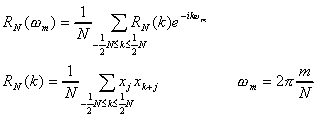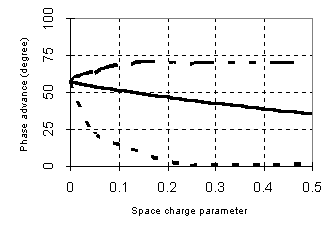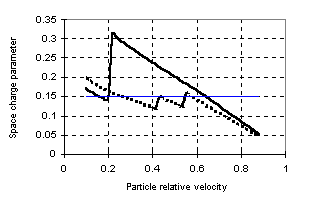The basic problems for construction of high intensity linear accelerator are providing of high efficiency, reliability and reduction of induced radioactivity in its parts. In the framework of ITEP feasibility study of linac for nuclear transmutation on energy about 1 GeV with a current up to 100 mA some new version of the accelerator is considered. It is shown that the rigidity of the focusing has to be increased to prevent large particle losses. For the given value of beam current it can be achieved by the using as short lengths of focusing periods as possible. Main part of the linac consists of a large number of single-gap independent accelerating cavities. It is supposed, that the basic constructional material for these resonators will be graphite.
It is shown, that such approach to design of main part of the linac allows to increase reliability of the accelerator, to reduce the requirements for mechanical tolerances of resonators and to improve parameters of a longitudinal movement of particles. It is also shown, that the replacement in large extent such conventional for linac design materials as steel, aluminium and copper on materials with small residual activation and low neutron production rate allows to increase the upper limit of permissible level of particle losses in linac. Graphite as main material of resonators will allow to build the linac with relatively low induced activization. It will provide handle maintainability at an achieved up to that time particle losses level.
The projects of the high power proton linacs (100 MW) have been offered in various laboratories for nuclear power installations. They are designed practically under the same block scheme with very similar parameters of the beam. They are conventional CW RF linacs based on several types of accelerating structures, which are working in the existing low power linacs.These structures are RFQ as an initial part of the linac, some versions of DTL for intermediate part with beam up to 100 MeV, DAW and CCL structures for acceleration of the beam up to target energy [1]. The parameters of these linacs are chosen from the spallation neutron production efficiency and the linac electrical efficiency. The value of the beam current 100 mA and output beam energy 1000 MeV, at the moment indicated in the most of the projects, are chosen to satisfy these requirements. The proposed projects are the realistic solution of a high power accelerator design. However there is not only the problem of efficiency. To build the linac with high average beam power of it is necessary to solve a critical problem of the accelerator parts activation. The permissible value of particle losses under conditions of hand - operated service of installation is equal 0.1 - 1.0 nA/m and depends on energy of the beam [1,2]. It means, that in the powerful linac constructed in accordance with the proposed schemes and with the parameters mentioned above, the level of relative losses should be reduced in two order of the magnitude in comparison with achieved in LAMPF linac level.
The processes, leading to the beam halo formation, are now under investigation very widely both analytically and with simulations of beam dynamics [3,4]. As result it was essential progress in the understanding of that fact, that particle motion nonlinearity at the presence of space charge is the main factor of the particle losses. Due to results of these investigations have been already changed some basic parameters of the proposed linacs in comparison with the projects, considered earlier: a current of the beam is reduced, a focusing strength and a aperture factor are increased, the better beam matching with the linac channels is provided etc. Nevertheless the existing methods for studies of beam halo formation give mainly qualitative results, not allowing to obtain exact value of particle losses in different parts of the linac. Therefore, problem of the minimization of particle losses in the linac is still actual.
The low activation of the powerful linac can be achieved not only by reduction of the level of losses, but also by using the materials with low induced activity for construction of linac accelerating structures and transport channels.
Opportunity of maintenance of low activation level of the accelerator both by an optimum choice of parameters of linac focusing channels and by use of the appropriate materials in the linac design is discussed below.
In spite of the facts that in a recent beam dynamics simulations are used very large number (1-2 106) macroparticles and the special codes for beam halo formation investigation were developed, there is no reliable method to predict the particles losses in the high power linacs [4,5]. It is due to extreme low allowable level of relative particle losses. The analysis of a beam motion nonlinearity degree and determination of its allowable level can be more convenient. According to the general nonlinear mechanics theorems the small nonlinearity should result in limited perturbation of the particle trajectories in phase space. The increasing of the nonlinearity degree leads to the particles motion in the phase space with mixing and, correspondingly, to the appearance of motion chaotization. The beginning of this process corresponds to a beam emittance growth.
The consideration of some specific spectral properties of dynamical
system in the transition region from order to chaos is given in
[6]. It is based on the study of the spectral
density of the correlation function ![]() calculated
for sequence of particle coordinates
calculated
for sequence of particle coordinates![]() stored
at certain crossection in every cell during the simulation. The
correlation function is:
stored
at certain crossection in every cell during the simulation. The
correlation function is:

In this expression ![]() determines the number
of stored points for every particle trajectory.
determines the number
of stored points for every particle trajectory.
It follows from given in [7] spectrum correlation function qualitative analysis that it is determined by structure of the phase space. In the presence of space charge it can see inside phase space the stability islands which correspond to the resonances of different orders [4]. The spectrum becomes wider and more uniform. There is one more universal spectral property. Well marked peak appears for zero frequency (so called "central peak"). It is due to some trajectories pass the vicinity of hyperbolic points of the separatrix for a very long time or pass near the border of stability region.
This method was used to analyze the ITEP beam dynamics simulation
results for the different structures of the high power linac.
The spectra were calculated for 300 particle trajectories in dependence
of space charge parameter![]() :
:
Where ![]() - length of focusing period in
unit;
- length of focusing period in
unit; ![]() - particle relative velocity;
- particle relative velocity; ![]() - relativistic factor;
- relativistic factor; ![]() - RF field wavelength;
- RF field wavelength;
![]() - transverse oscillation phase advance
at zero current;
- transverse oscillation phase advance
at zero current; ![]() - characteristic current
equal for protons 3.13 107 A;
- characteristic current
equal for protons 3.13 107 A; ![]() - average
beam current;
- average
beam current; ![]() - normalized beam emittance.
- normalized beam emittance.
This combination can be a fruitful for estimation of nonlinearity degree of particle motion in focusing channel.
The results of ITEP simulations analysis are shown in fig. 1.
In this figure are presented data for DTL section (intermediate part of an accelerator) with the parameters of the beam and channel given in Table 1.
The curves in figure represent dependences of average frequency
![]() in the spectrum of corresponding correlation
functions, and also the lower
in the spectrum of corresponding correlation
functions, and also the lower![]() and upper
and upper
![]() borders of the spectra on space charge
parameter
borders of the spectra on space charge
parameter ![]() .
.
It follows from the figure that for ![]() the
particles with zero frequency appear in the beam. The presence
of zero frequency in a spectrum of correlation function (central
peak) testifies that some particles change their amplitudes under
influence local instabilities. In the simulation results displayed
in Fig.1, the lower border of a spectrum reached zero at h = 0.2,
and the emittance growth began be considerable starting from the
same point. It is possible to assume, that the value
the
particles with zero frequency appear in the beam. The presence
of zero frequency in a spectrum of correlation function (central
peak) testifies that some particles change their amplitudes under
influence local instabilities. In the simulation results displayed
in Fig.1, the lower border of a spectrum reached zero at h = 0.2,
and the emittance growth began be considerable starting from the
same point. It is possible to assume, that the value ![]() of space charge parameter
of space charge parameter ![]() at which the
lower spectrum border of the correlation function reaches zero,
can serve as the upper limit of a beam current for the given channel,
at which the particles motion has laminar character.
at which the
lower spectrum border of the correlation function reaches zero,
can serve as the upper limit of a beam current for the given channel,
at which the particles motion has laminar character.

| Operating frequency | 350 MHz |
| Initial average frequency of transverse oscillations | 600 |
| Length of focusing period | 2 |
| Type of focusing period | FODO |
| Beam emittance | 0.2 cm.mrad |
| Beam energy | 100 Mev |
The space charge parameter, calculated for the schemes without beams funneling proposed in [1] (LANL) and [8] (ITEP) for an average beam current 100 ìÀ are shown in fig. 2. As it can be seen, in ITEP project of accelerator the space charge parameter slightly exceeds the specified above limit in the accelerator intermediate part, and in LANL linac this parameter exceeds the limit in several times. It is due to using in the last case the focusing period lengths with n = 10, beginning with rather low beam energy. Our results show that in this case it will lead to fast halo formation in this part of the accelerator. To decrease this effect it is necessary to use shorter focusing period in the linac at least at beam energy lower 200 - 300 MeV.
The radiating problems can be solved not only by reduction of the particle losses in comparison with achieved level, but also by application of materials, having considerably smaller level of induced radioactivity [2]. One of such material is, for example, graphite, for which there are advanced technologies of employment in radiating engineering.

If to reduce the use of copper and steel as constructional materials in the linac as much as possible and to replace them by graphite (in which lost particles will be mainly absorbed), the level of radioactivity will be considerably lowered. The accelerator becomes practically clean from the radioactivity point of view up to energy of 25 MeV at any level of beam losses. In this energy range residual radiation is caused by 13N and 11C radionuclides with half-life time of 10 and 20 minutes accordingly, and, hence, radiation near to accelerator is quickly reduced up to allowable level.
Because neutron yield of carbon is less than 10 % of copper, the beam focusing can be provided in DTL by permanent magnets.
The allowable level of induced radioactivity of the accelerator with use of graphite corresponds to essentially more high level of the particle losses. At proton energy above 500 MeV of the dose power during 2 hours after switch off the beam becomes 100 times less, than in the case of using of traditional materials for the same beam losses.
The principal possibility of application of graphite in accelerating channel constructions results from physical process features of particles losses in linac. As the accelerated beam has small phase volume, lost particles fall on internal wall with angle less than 10 mrad and, hence, their trajectories pass in thin surface layer. The depth of proton penetration is increased due to repeated Coulomb dissipation of protons on atoms of the wall. The given dependence is obtained in assumption of a uniform distribution of particles losses along the channel and taking into account the fact, that capture of the lost particles takes place in the inner wall substance due to nuclear interactions. The penetration depth is smaller than aperture radius at energies 100 MeV while at the energy range 100 - 1000 MeV the penetration depth is comparable to the accelerating structure sizes.
Our calculations show that in the case of the "graphite" accelerator with 100 mA average beam current relative beam losses should be only slightly lower than those are in LAMPF now to have suitable activation level at high power linac. The permissible level of the relative particle losses may be in our case 10-4 - 10-5. The progress of the accelerator science and engineering during last period allows to hope that this value is achievable goal.
The permissible level of activation is one of the most important parameters for of high power linac design. It can be possible to achieve required level by decreasing of particle losses and appropriate choice materials of accelerating structures and transport channels. In this report the introducing of the upper limit of space charge parameter is discussed. The limit is based on the study of the spectral properties of the transverse particle oscillations. It is shown that space charge parameters should not exceed value corresponding only 15% phase advance depression. For average beam current 100 mA it leads to shorter focusing period lengths along the linac then in earlier proposed projects of the high power linac.
The introducing into construction of the linac materials with low residual activity and low neutron yield improves considerably the radiation situation at the high power linac. To have hand-on maintenance of the linac the relative beam losses may be only slightly less than those in LAMPF now.
The results of the beam dynamics analysis and study of interaction lost particles with linac materials led to development in ITEP of the new conception of high power proton linac design [9]
Further development of the proposed version of the accelerator design requires thorough numerical calculations. The understanding of the picture of the transport of particles being lost, which undergo multiple reflection prior to their absorption, will help the development of methods for smoothing out the distribution of losses.
It is also necessary to solve technical problems of graphite use in deep vacuum and strong electric fields.
[1] G.P. Lawrence. "Transmutation and Energy Production with High Power Accelerators", Proc. of PAC 95 Conf., p.35
[2] A.A. Drozdovsky. "Induced Radioactivity Decrease Method in High Intensity Linac", Proc. of EPAC-96, to be published.
[3] N. Brown and M.Reiser. "Current Losses and Equilibrium in RF Linear Accelerators", Proc. of PAC 95 Conf., p.1170.
[4] R.D. Ryne, S. Habib and T. Wangler. "Halos of Intense Proton Beams". Proc. of PAC 95 Conf., p.3149.
[5] J. Lagniel, Nucl. Inst. Meth. A345, 46 (1994).
[6] G.M. Zaslavsky, R.Z. Sagdeev. "Introduction to Nonlinear Physics", Nauka, Moscow, 1988.
[7] V.V. Beloshapkin, G.M. Zaslavsky. "On the Spectral Properties of Dynamic Systems in the Transition Region from Order to Chaos". Phys. Lett., v.97a, ¹ 4, 1983.
[8] V.A. Andreev, et.al., "New Approach for High Power Ion Linac Design", The Intern. Conf. on Accelerator-Driven Transmutation Technologies and Applications, Kalmare, June, 1996.
[9] V.A. Andreev at al. "Engineering Design of ITEP Proton Linac for Nuclear Wastes Transmutation", ibid.